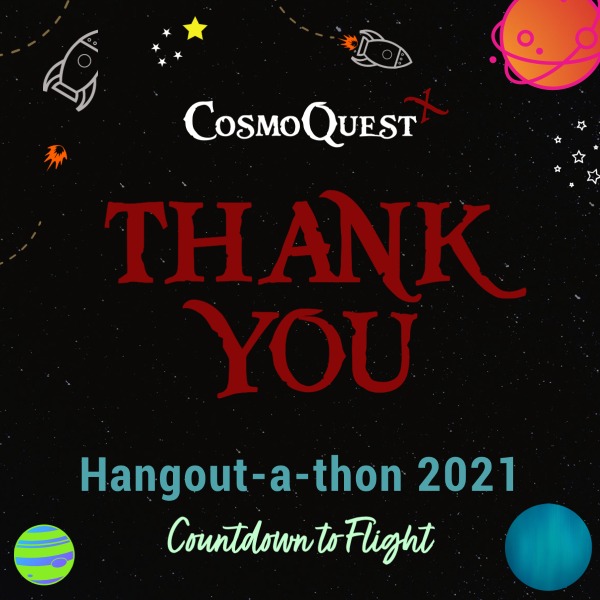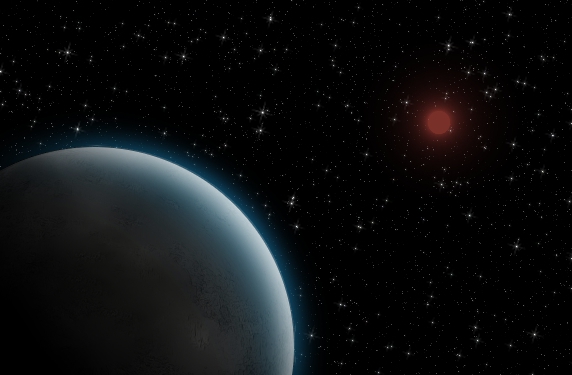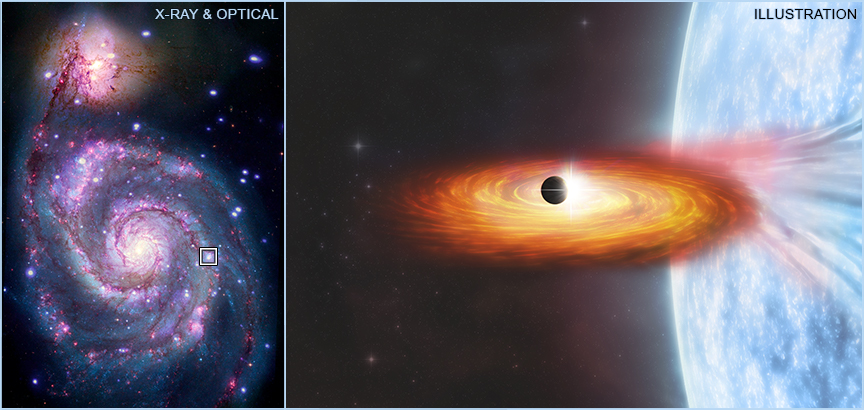A proposed mission called the Contemporaneous LEnsing Parallax and Autonomous TRansient Assay, or CLEoPATRA, seeks to work with the Nancy Grace Roman Telescope to find rogue planets not orbiting any star. Meanwhile, a possible planet has been discovered in the Whirlpool Galaxy and could be the first planet found outside the Milky Way. Plus, an interview with Dr. Margaret Meixner, Director of Science Mission Operations for the SOFIA telescope.
Podcast
Show Notes
A supernova shines in a crowded galaxy
- NASA Goddard press release
- “Progenitor and close-in Circumstellar Medium of Type II Supernova 2020fqv from high-cadence photometry and ultra-rapid UV spectroscopy,” Samaporn Tinyanont et al., 2021 October 26, Monthly Notices of the Royal Astronomical Society
Moon-forming disk found around a giant planet(?)
- NOVA press release
- “Characterizing the protolunar disk of the accreting companion GQ Lupi B,” Tomas Stolker et al., to be published in The Astronomical Journal (preprint on arxiv.org)
Youngest planet directly observed
- Keck Observatory press release
- “Zodiacal Exoplanets in Time (ZEIT) XII: A Directly-Imaged Planetary-Mass Companion to a Young Taurus M Dwarf Star,” E Gaidos et al., 2021 October 26, Monthly Notices of the Royal Astronomical Society
Saturn’s moons multiply in known numbers
- How Many Moons Does Saturn Have? A Lot More Now: Dozens of New Ones Have Just Been Found. (Syfy Wire)
- “Evidence for a Recent Collision in Saturn’s Irregular Moon Population,” Edward Ashton, Brett Gladman, and Matthew Beaudoin, 2021 August 10, The Planetary Science Journal
Planned CLEoPATRA mission will measure rogue planets
- NASA Goddard press release
Possible planet found in Whirlpool Galaxy (M51)
- CXO press release
- ESA press release
- “A possible planet candidate in an external galaxy detected through X-ray transit,” Rosanne Di Stefano et al., 2021 October 25, Nature Astronomy
Transcript
Hello and welcome to the Daily Space. I am your host Dr. Pamela Gay.
And I am your host Beth Johnson.
And we are here to put science in your brain.

Before we get to our regular show, I just want to take this moment to say thank you to all of you who were part of our CosmoQuest Hangoutathon this past weekend. Thanks to your generosity, during this 36-hour fundraiser, we were able to raise over $40,000. These funds will support not just this show, but all the shows put out by CosmoQuest, including 365 Days of Astronomy, Astronomy Cast, the Weekly Space Hangout, and more.
Thank you! Your help is going to allow us to keep bringing you science and awesome guests like today’s guest Dr. Margaret Meixner, the Director of Science Mission Operations for the Stratospheric Observatory for Infrared Astronomy or SOFIA telescope. She’ll be joining us later on in the show.
But first, the news.
And now for some science. Or at least a pretty picture that contains a lot of information that yields amazing discoveries.

The Zwicky Transient Facility recently discovered a star-going supernova in a field the TESS planet hunter just happened to be observing. Recognizing a unique opportunity to catch a supernova going off in a field that was being actively observed in the time leading up to the blast, the Hubble Space Telescope was pulled off its normal planned set of observations and directed at this special event.
The supernova went off in the Butterfly Galaxies – a beautiful pair of merging systems located about 60 million light-years away. The fact this is such a scientifically interesting merger – one that just happens to also be stunningly beautiful – means that there are observations of this system and the star that went supernova going all the way back to the 1990s.
This combination of historic data taken multiple times with Hubble over thirty years and data from TESS taken every thirty minutes in the days leading up to the discovery, combined with Hubble data taken right after the supernova went off led the research team to dub this object, officially named SN2020fqv “the Rosetta Stone of Supernovae”.
According to observer Ryan Foley: We used to talk about supernova work like we were crime scene investigators, where we would show up after the fact and try to figure out what happened to that star. This is a different situation, because we really know what’s going on and we actually see the death in real-time. … This is really the most detailed view of stars like this in their last moments and how they explode.
These observations may even allow us to develop an early warning system to identify the next star that is about to die.

The sky is vast, and it’s very rare that we just happen to be looking in the right direction by accident to catch something amazing. Luckily, we often get hints of “here lies the remarkable.”
Recently, astronomers observed the variable star GQ Lupi’s giant planet, or possibly brown dwarf companion, it’s hard to tell because this is a young system still forming. And because it’s a young system still forming that has a giant planet, or brown dwarf, they were able to ask, “How do the moon systems of Jupiter-like world’s form?” and get an answer.
Direct imaging using the Very Large Telescope (VLT) in Chile was able to make out a warm disk around the Jupiter-like object, and it seems to indicate that moons form in a disk around the planet just as planets form in a disk around the star. While the VLT is the best telescope we have today, team lead Tomas Stolker pointed out that: Webb can take spectra at mid-infrared wavelengths. That is very challenging from Earth. In doing so, we could learn much more about the physical and chemical processes in the disk of GQ Lupi B that may enable the formation of moons.
Here is to hoping that JWST finally gets off this planet and lets us start looking at other worlds. This work is published in The Astronomical Journal.

It’s kind of amazing that we have really only been in the planet finding business since 1995. From barely being able to detect worlds from how they move their stars, we have now evolved our technology to be able to directly image planets. In new data from the Subaru Telescope in Hawaii researchers caught sight of the youngest planet directly imaged to date.
Dubbed 2M0437, this planet is about 100 times the Earth-Sun distance from its star, and researchers estimate that it is a few times bigger than Jupiter. According to lead author Eric Gaidos: By analyzing the light from this planet we can say something about its composition, and perhaps where and how it formed in a long-vanished disk of gas and dust around its host star.
We have one final bit of news: the Saturn system has grown in the number of known moons. Observations with the 2.6-meter Canada France Hawaii Telescope in Hawaii has brought the number of known moons up to 82, and researchers now estimate that there are 150 moons (give or take 30) larger than 2.8-kilometer orbiting the ringed planet. That is a lot of moons.
Archimedes famously said: Give me a lever long enough and a fulcrum on which to place it, and I shall move the world. Luckily, no such lever or fulcrum has been placed, so our world keeps safely orbiting. This is a case where the physics of the saying is true, but the reality of we humans and our engineering doesn’t allow us to take advantage of that physics.
There are lots of cases like this. For instance, to measure the distance to an object using basic trigonometry, we need to be able to observe that object from two separate positions. Humans use two eyeballs to perceive distances to objects around us. Astronomers use the Earth’s motion around the Sun to get measurements of the distance to nearish stars. Our ability to measure distances is only limited by where we can observe from. Give us two measurements far enough apart, and we could measure the distance to anything in the visible universe.

And this is where the CLEoPATRA mission comes in. Written out, this acronym stands for Contemporaneous LEnsing Parallax and Autonomous TRansient Assay, and the plan is to stick this mission on a ride out toward Mars with a future Mars mission. It will be placed in a solar orbit that will allow it to make coordinated observations with the planned Nancy Grace Roman space telescope to observe objects. Acting as two eyes, this pair of systems will allow researchers who spot rogue planets to figure out their distance. According to mission scientist Richard Barry: The parallax signal should then permit us to calculate quite precise masses for these objects, thereby increasing scientific return.
Now, this story somewhat buries the lede: I said this mission will help measure the distance to rogue planets. These are planets that have been flung out of their star systems at some point in the past and now lurk between the stars. They can be seen when they ever so briefly pass in front of a distant star and gravitationally increase the amount of light we can see. This is only possible for a brief moment in time, and in the past, observations didn’t allow us to measure distances to these objects.
With CLEoPATRA out there, we have that farther apart pair of telescopes that makes measuring greater distances possible.
Rogue planets are one thing, but this next story could be a massive discovery.

Scientists using the ESA’s XMM-Newton and NASA’s Chandra X-ray telescopes may have found a planet in another galaxy. Not surprisingly, the methods that work for finding exoplanets here in the Milky Way, like transits and gravitational shifts, don’t work when looking at another galaxy because the visible light is hard to break apart into objects. But X-rays work really well since there are far fewer objects that shine in X-ray light, so the data collected can be analyzed to differentiate between a variety of X-ray sources.
In this case, scientists looked for X-ray binaries, which are pairs of objects such as a neutron star or black hole and a so-called donor star whose material is being pulled in by the denser object. The acceleration of the infalling star stuff produces bright X-rays, and as lead author Rosanne Di Stefano explains: X-ray binaries may be ideal places to search for planets, because, although they are a million times brighter than our Sun, the X-rays come from a very small region. In fact, the source that we studied is smaller than Jupiter, so a transiting planet could completely block the light from the X-ray binary.
And that’s what Di Stefano and her team observed in the Whirlpool Galaxy while looking at an X-ray binary named M51-ULS-1. A light dip blocked the X-ray signal for a few hours before coming back. Of course, that didn’t automatically mean this is a planet. The team had to rule out a bunch of other options like dust, a small star, or variability from the source itself. They even ruled out that it was the source star passing in front of the dense object. Now, Di Stefano clarifies: We can only say with confidence that it doesn’t fit any of our other explanations.
So don’t go counting your extragalactic planets until they’ve really been confirmed. This work is published in Nature Astronomy, and the news is exciting because it almost mirrors the discovery of the first exoplanet, which was found orbiting a pulsar and was observed in the X-ray wavelengths as well. Perhaps we are seeing the start of a new field of astrophysics!
Interview

Joining us now is Dr. Margaret Meixner, the Director of Science Mission Operations for the Stratospheric Observatory for Infrared Astronomy or SOFIA telescope, and Suraiya Farukhi, the Director of External Communications for the Universities Space Research Association.
Dr. Meixner provides scientific, technical, and management guidance for the SOFIA team while working in partnership with the Deutsches SOFIA Institute. Suraiya handles the media and press communications for the SOFIA team.
The SOFIA telescope is a 2.7-meter (106-inch) reflecting telescope installed on board a modified Boeing 747SP aircraft, which flies at 38,000-45,000 feet and puts SOFIA above 99 percent of Earth’s infrared-blocking atmosphere. Over the past year, SOFIA has enabled the discovery of water on the Moon, the mapping of magnetic fields in the Whirlpool Galaxy, and the measurement of atomic oxygen in our own atmosphere, to mention just a few results. It’s truly an amazing observatory.
Thank you, Dr. Meixner, and thank you, Suraiya, for joining us today.
[Transcript unavailable.]
This has been the Daily Space.
You can find more information on all our stories, including images, at DailySpace.org. As always, we’re here thanks to the donations of people like you. If you like our content, please consider joining our Patreon at Patreon.com/CosmoQuestX.
Credits
Written by Pamela Gay and Beth Johnson
Hosted by Pamela Gay and Beth Johnson
Audio and Video Editing by Ally Pelphrey
Content Editing by Beth Johnson
Intro and Outro music by Kevin MacLeod, https://incompetech.com/music/


 We record most shows live, on Twitch. Follow us today to get alerts when we go live.
We record most shows live, on Twitch. Follow us today to get alerts when we go live.